New Vista Exploration in the Cultural Integration of East and West
——On Wang Huanting’s Oil Paintings
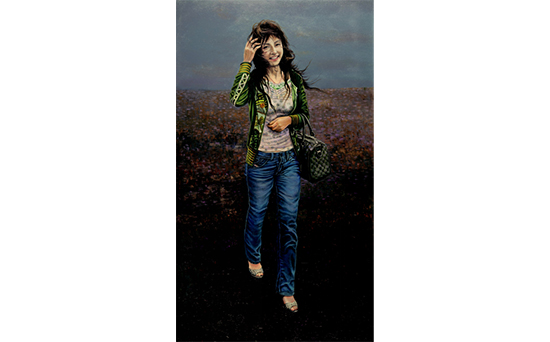
Spring Breeze
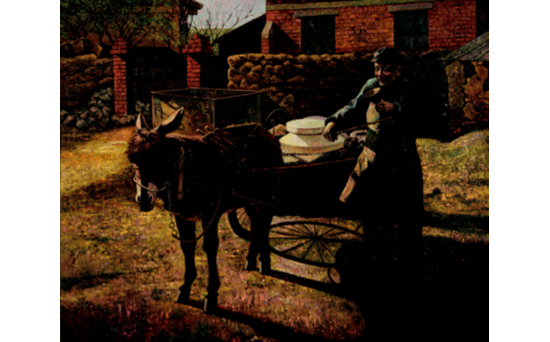
The Bell Rings in Spring
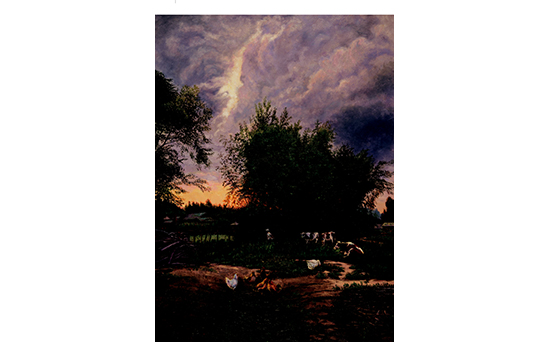
Entrance to a Village
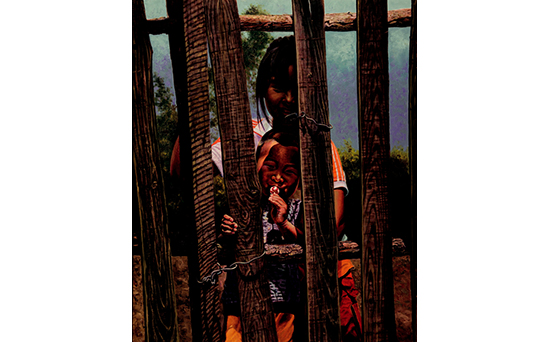
Those Left Behind
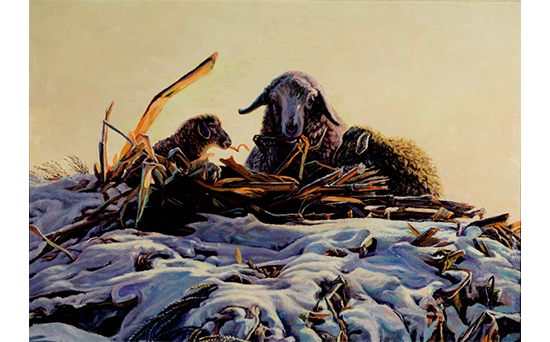
Bliss in Three Rams
Apainter’s vision, style, vitality and mission in art are determined by his or her hometown, life experience and pursuit while a painter’s personal experience will lead to his or her approach in art. Like every stream that ultimately runs into river or sea, every slice of enlightenment along the living path, every kind of innovation in art experiment, every success in acquisition of technique or skill and even every wink of inspiration or perseverance against hardship demands efforts and contributes to the perfection of life and art. By exhibiting his or her artworks full of devotion, a painter opens his or her heart to viewers and tells about his or her living story. Therefore, a genuine artist’s art exhibition must be a sacred occasion where the artist has a spiritual impact, dialogue and eye contact with the viewers. In the art dialogue with Wang Huanting, there are following three perspectives worthy of our attention.
The first perspective is his art resume. Born in Harbin in Northeast China in 1958, Wang Huanting has borne a particular passion for fine arts and kept practicing painting since his childhood. He used to learn at painting class in the Children’s Palace until the age of 16 when his training in fine art was suspended during the Cultural Revolution. Soon after the policy of reform and opening up was adopted, he was admitted into the Painting Department of Harbin Workers and Farmers Educational College. Upon graduation, he went to Japan for further study in 1988 as a personal assistant of Kaii Higashiyama, a master in Japanese fine art circle. During his stay in Japan, he made an all-round, in-depth and systematic research of Japanese painting, lacquer painting and woodcarving. He even spent over a decade on technologies in Chinese dynasties of Han, Tang, Song, Yuan and Ming such as lacquer painting, gold foil, carved lacquer, immersion gold and scattered gold. With a proficiency in Chinese traditional realistic painting, Japanese rock painting and maki-e, Wang Huanting has achieved a superb mastery of equipments and techniques in woodcarving. Then he spared no efforts to explore a new approach on the integration of oil painting, woodcarving and lacquer painting.
As early as in 1983, his oil painting Mom, I’m Coming was included into the provincial fine arts exhibition in Heilongjiang and two years later his work Changing Life won the Award of Excellence in the national workers’ fine arts exhibition. Afterwards, he participated in provincial figure oil painting exhibitions and other oil painting exhibitions on many occasions. From the year 1988 on, he held his personal oil painting exhibitions many times in Japan, and in 1991, he held his personal woodcarving and lacquer painting exhibition in Tokyo. In 2003, his oil painting Child in Village was involved into the national oil painting exhibition and from the year 2006 on, he has held personal exhibitions in Khabarovsk in Russia. Since 2009, he has consecutively staged his personal tour in Guangzhou, Beijing and so on and since 2010, he has been engaged as deputy director general of Oil Painting Art Committee of Heilongjiang Provincial Artists Association.
From his resume, we can obviously see that Wang Huanting has undergone a long-term training and painstaking study in oil painting as well as reference in Japanese fine arts, and he has gained abundant experience about landscape, urban and rural expressions in Northeast China and Japan. Moreover, he has become a distinguished artist with his unique artistic creation and exploration as the contents, style and characteristics of his paintings are outcome of his years of accumulation and exploration in arts instead of mere imitation.
The second perspective is his style in art. With main creation in oil painting, Wang Huanting is good at lacquer painting and woodcarving as well, both of which are significant approaches of fine and applied arts of a time-honored history and profound tradition in China and Japan. Wang’s artistry from oil painting to applied arts will easily remind us of Qi Baishi, a master of traditional Chinese painting evolving from a simple artisan, but Wang’s exploration in art is more difficult. He endeavors not only to combine applied arts with oil painting, but also to integrate essentially Oriental arts and Occidental arts in a perfect harmony so as to bring about extraordinary charm in arts. As a matter of fact, this is just Wang’s unique style, ideal, highlight and innovation in oil painting.
While inheriting and strengthening the realistic tradition of oil painting art, Wang Huanting manages to infuse some subjective, decorative, intentional and artistic elements into his works. In his works about landscape in Northeast China, his thick and heavy colors highlight and recapture the open country, snowstorm, folklore, rural community and figures in a distinctive style of realism. However, all his works convey a different sense of his own as some gloomy tune or some semi-realistic details produce an atmosphere of art. They are neither as vivid as true objects depicted in classic oil paintings nor tiny accessory in oil paintings of Impressionism or Abstract School that stress on subjective light, shadow and colors. Wang’s style in oil painting, based upon traditional realism, is not a simple imitation of Objectivism but intentionally endowed with craftsmanship, print style and decorative feature. For example, some details of high application purpose are more vivid than true objects while the main body looks far from reality as a deliberate detachment. In a word, my conclusion is that, different from oil paintings of his ancestors and peers, his works enjoy a unique style, character and pattern, none of which could be reproduced or imitated. Wang’s oil paintings are completely outcome of his own experience in life and art, in Western forms but with a particular Oriental taste, quality, aesthetics, technique and tradition. As to cultural integration of East and West, his unprecedented vast vision enables him to manage integration and mutual reference of East and West with such abundant background factors as China, Japan, history, tradition and folklore. Undoubtedly, his exploration, though quite difficult, is blessed with a profound significance and aesthetic value in arts.
The last perspective is his achievement in art. With painstaking efforts, Wang Huanting created two large-scale oil paintings. One is about ancient Chinese military forces’ war against Japanese pirates in Ming Dynasty and the other is about voluntary army’s fighting against Japanese invaders in Northeast China in the 1930s. The two giant artworks of the same theme of resistance against Japanese invaders are considered to be epic creations of magnificent event and massive figures and typical presentation of Wang Huanting’s art complex. As a native of Northeast China and a traveler in Japan for quite a long time, Wang has profoundly experienced and pondered over the history of China and Japan. As an artist full of patriotic spirit, Wang Huanting has not only conducted unique observation and study of this sensitive history, but also made long-term and sophisticated preparation for his artistic creation. “I have lived abroad for more than two decades, which results in my deep affection and nostalgia for my motherland and patriotic spirits.” he said. His enthusiasm for those historical creations can be sourced back to his living in Japan, and for this reason, he made such a particular survey about ancient Japanese costumes, samurais’ combat actions and daily mentality that a large quantity of materials and sketches were accumulated. His research about Chinese military forces such as General Qi Jiguang’s army or army from Hunan Province tells differences about soldier, private and warrior and that about Japanese military forces tells about samurai, ronin and ninja. Wang even adopted the game of go to simulate battle formation and his repeated deployment and removal for over scores of times finally led to a comprehensive format, structure and figures’ varied motion. As far as the warfare reproduction and figure details in painting, there is hardly any painter like Wang Huanting who is so accurate with the reality in history. As a result, Japanese viewers unanimously suppose that they have seen the authentic appearance of their ancestors in a foreigner’s oil painting. At one am, he would get up to start a new day’s creation and in this way, he spent nine years until completion. To some extent, Wang’s representative works are outcome of his decades of preparation and nearly a decade of artistic creation. The grand spectacle of warfare in the age of Cold Steel was depicted in the Southeast Battle led by General Qi Jiguang against Japanese pirates. Countless figures of varied features and distinct gradation provide a shocking naval battle, heroic sacrifice on beaches and Chinese glorious victory over invaders. In the painting of voluntary army of Northeast China, the military banner and fire are shining against white snow and red blood. Riding horses in heavy snow and immense forest bravely, such heroes as Zhao Shangzhi and Yang Jingyu outshine the sun and the moon and become as eternal as mountains and rivers, for whom the painter expressed respect, praise and eulogy to the utmost. The two giant paintings are vivid and profound reflections of Chinese people’s memory about this unforgettable history.
If a painter can find an art language of his own, establish his own art features and present some significant works closely related to his life, motherland, national destiny and human history in artistry, his creation is well worthy of our respect because all those painters who earn their places in history have traveled the same path. Hopefully, Wang Huanting will bring more promising works to us in the future.














